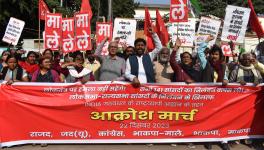Bihar: Sand Crisis May Hit People Again After Reports of Likely Ban on Mining Soon
Sand mining in India. Image Courtesy: Wikimedia Commons
Patna: Sand availability in Bihar is likely to face trouble soon due to a likely ban on mining this month, creating a crisis for construction activity.
An advisory message sent out from the state mines and geology department to different government departments asks them to stock sufficient amount of sand for construction work.
This news has panicked people, construction contractors, builders and others, whose under-construction projects will be affected.
Sand mining had resumed in the state on October 1. It had been banned for four months — from June 1 to September 30 this year -- following a National Green Tribunal (NGT) order, as well as a Supreme Court order.
According to a senior official in the state mines and geology department, sand mining is likely to be banned from December 25 in view of an interim order of the Patna High Court.
“Different departments have been alerted, including road construction, rural work, rural development, water resources, education, health, urban development, building construction, and PHED to ensure stocks of adequate sand because sand mining will be banned again. The advisory is to minimise the risk of sand crisis that may badly affect different construction works of the government,” officials said.
However, the department has officially not announced anything yet. But, common people are worried about the likely sand crisis. “This will result in the sand crisis and will add to already skyrocketing costs of construction in the state. What can we do, the crisis is a big problem for people who are constructing their house,” Rameshar Prasad Singh, 62, who is constructing his house at a colony in Phulwarisharif on the outskirt of Patna, told NewsClick.
Middle-aged Kamlesh Mahto said it was a failure on the part of the government that the sand crisis affected common people. “I am constructing my house in Danapur in Patna, I don't have enough money to stock sand. The sand mafia will make money out of the crisis as they did early this year,” he told NewsClick.
Irshad Ansari, a construction contractor, told NewsClick that the sand crisis would directly hit the booming construction sector. “It is not only common people, projects of builders, contractors will be affected badly,” he said.
Gopal Sharma, a builder, appealed to the government to do everything to end the threat of a sand crisis. “Thousands of projects, including bridges, buildings and road construction will be affected if a sand crisis hits the state,” he added.
In September, ignoring the absence of a scientific study and data on the impact of sand mining on river beds and the environment in Bihar, the state government had doubled sand mining ghats to increase revenue. This had raised eyebrows among river experts and environmentalists.
Until May 30, 2022, sand mining was being done on 435 ghats on different rivers in 16 districts. The state mines and geology department plans to allow sand mining on 900 river ghats in 28 districts.
However, till date, there is no scientific study or data on the impact of sand mining on rivers. River experts and environmentalists have warned that mindless sand mining had already ruined river ecosystems, health and biodiversity. Kiul river is on the verge of extinction, and the Sone river bed is damaged. The yellow sand of Sone is in high demand in the construction sector, unlike Ganga, which is grey said that is mainly used for filling.
The state mines and geology department recently directed the district officials to finalise the settlement of lease of authorised ghats on different rivers for sand mining. “The department has already issued an advertisement for an e-tender to lease ghats for sand mining,” a department official told NewsClick.
After realising that it cannot check illegal sand mining by powerful nexus in the widespread riverine belt that also causes huge losses to the public exchequer, the state government has decided to increase sand mining with certain regulations to earn more revenue.
The department recently got a list of 238 sand dunes in 29 rivers from the water resources department. It claimed that this had resulted in the creation of more than 200 big islands due to increasing silt problems in the rivers.
Last August, the government had hiked the royalty to be paid by sand miners from five rivers -- Sone, Kiul, Falgu, Chanan and Morha -- from Rs 75 to Rs 50/cubic metre, as another move to increase revenue from sand mining.
Last year, the then-state mines and geology minister Janak Ram said that the state government incurs an annual loss of Rs 700 crore due to illegal sand mining.
So far, the government has prepared a District Survey Report (DSR) to ensure that sand mining is done in a sustainable and "environment-friendly manner", but this has been violated by sand miners. The DSR is based on studies about the presence of sand and other minerals in a district and lists ways in which they can be extracted sustainably to inflict minimum damage to the riverine ecology.
Get the latest reports & analysis with people's perspective on Protests, movements & deep analytical videos, discussions of the current affairs in your Telegram app. Subscribe to NewsClick's Telegram channel & get Real-Time updates on stories, as they get published on our website.
























